Abstract
Rapid growth and the concentration of hog production in North Carolina have raised concerns of a disproportionate impact of pollution and offensive odors on poor and nonwhite communities. We analyzed the location and characteristics of 2,514 intensive hog operations in relation to racial, economic, and water source characteristics of census block groups, neighborhoods with an average of approximately 500 households each. We used Poisson regression to evaluate the extent to which relationships between environmental justice variables and the number of hog operations persisted after consideration of population density. There are 18.9 times as many hog operations in the highest quintile of poverty as compared to the lowest; however, adjustment for population density reduces the excess to 7.2. Hog operations are approximately 5 times as common in the highest three quintiles of the percentage nonwhite population as compared to the lowest, adjusted for population density. The excess of hog operations is greatest in areas with both high poverty and high percentage nonwhites. Operations run by corporate integrators are more concentrated in poor and nonwhite areas than are operations run by independent growers. Most hog operations, which use waste pits that can contaminate groundwater, are located in areas with high dependence on well water for drinking. Disproportionate impacts of intensive hog production on people of color and on the poor may impede improvements in economic and environmental conditions that are needed to address public health in areas which have high disease rates and low access to medical care as compared to other areas of the state.
Full text
PDF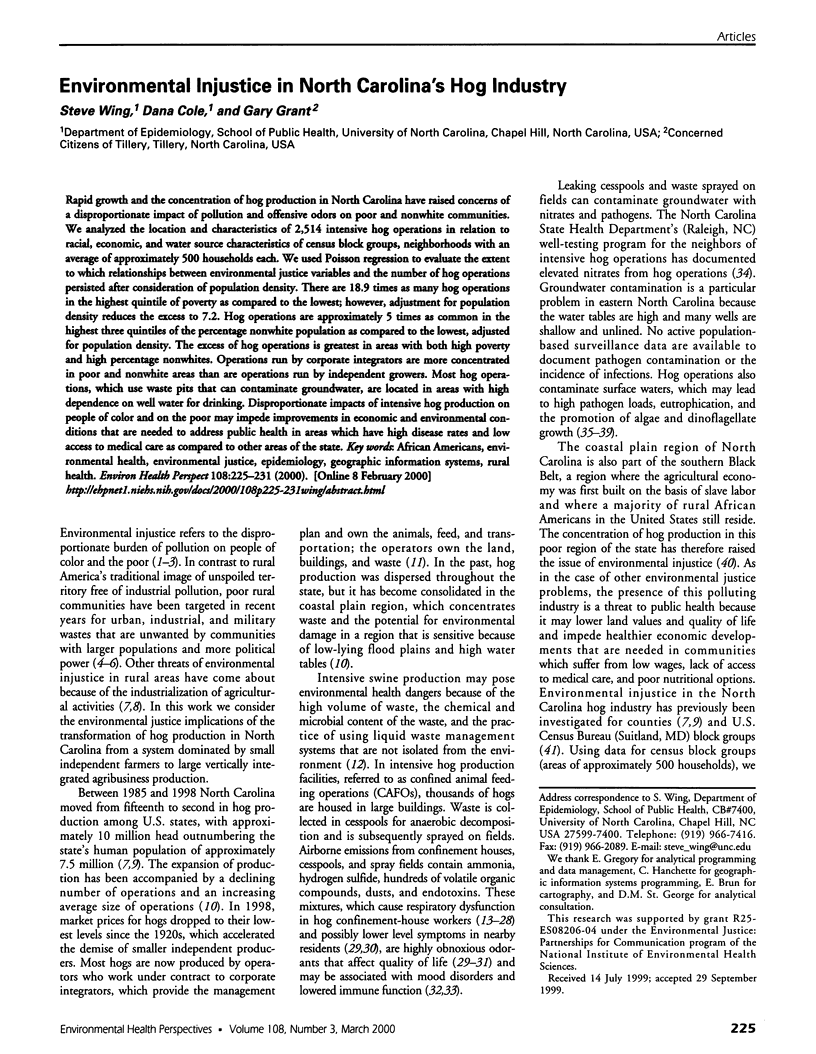
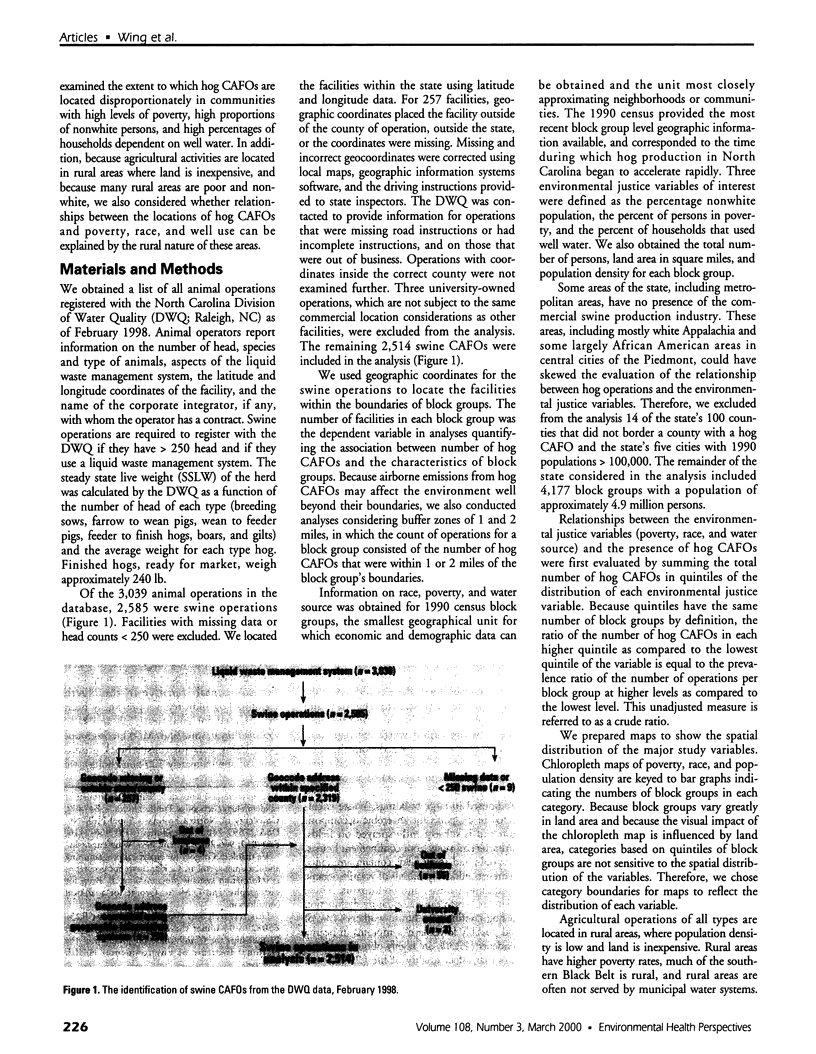
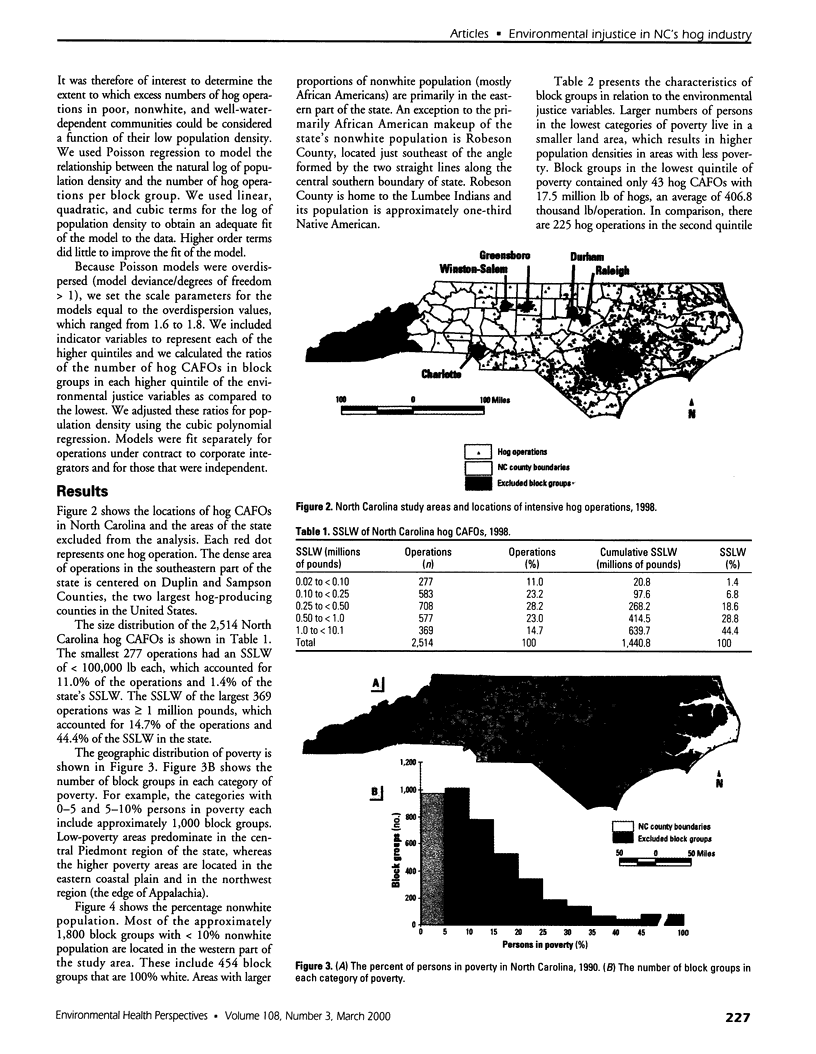
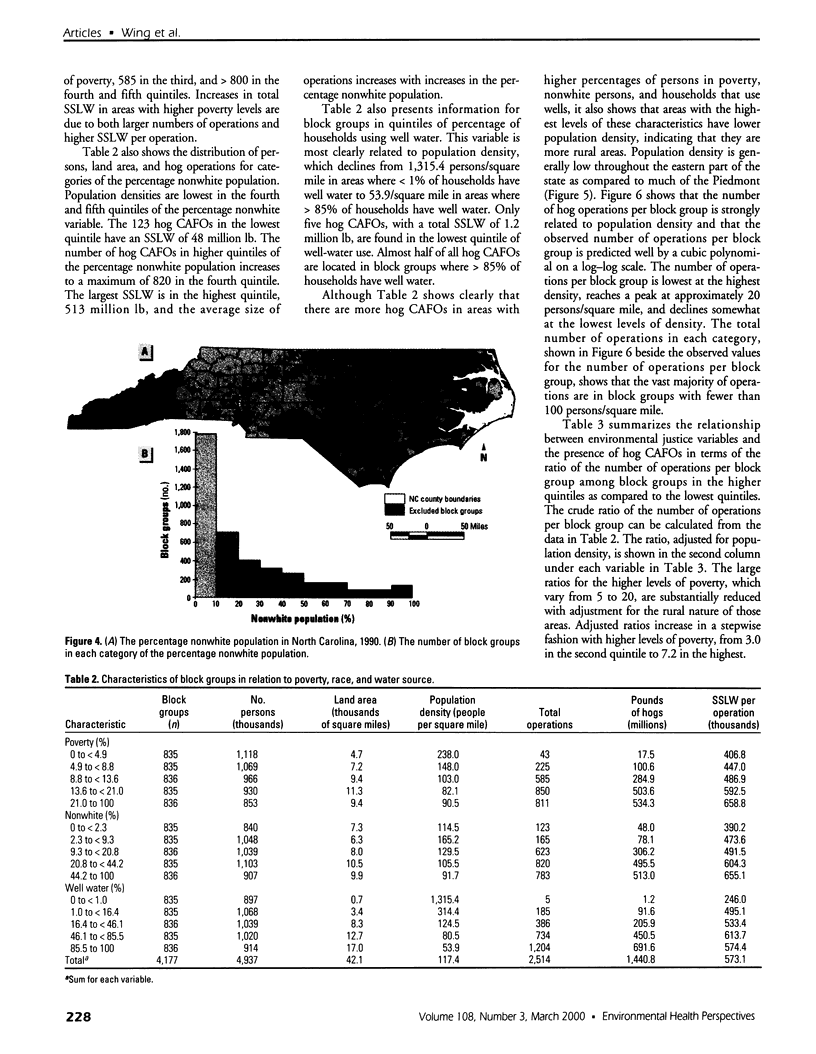
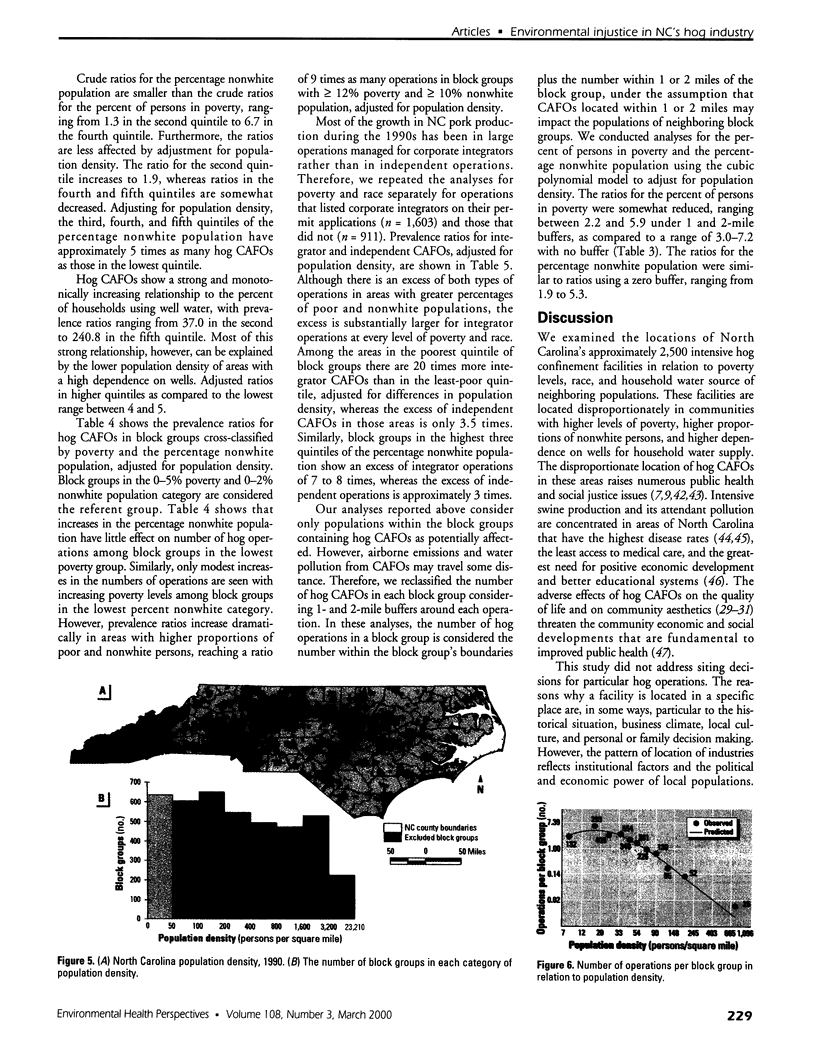
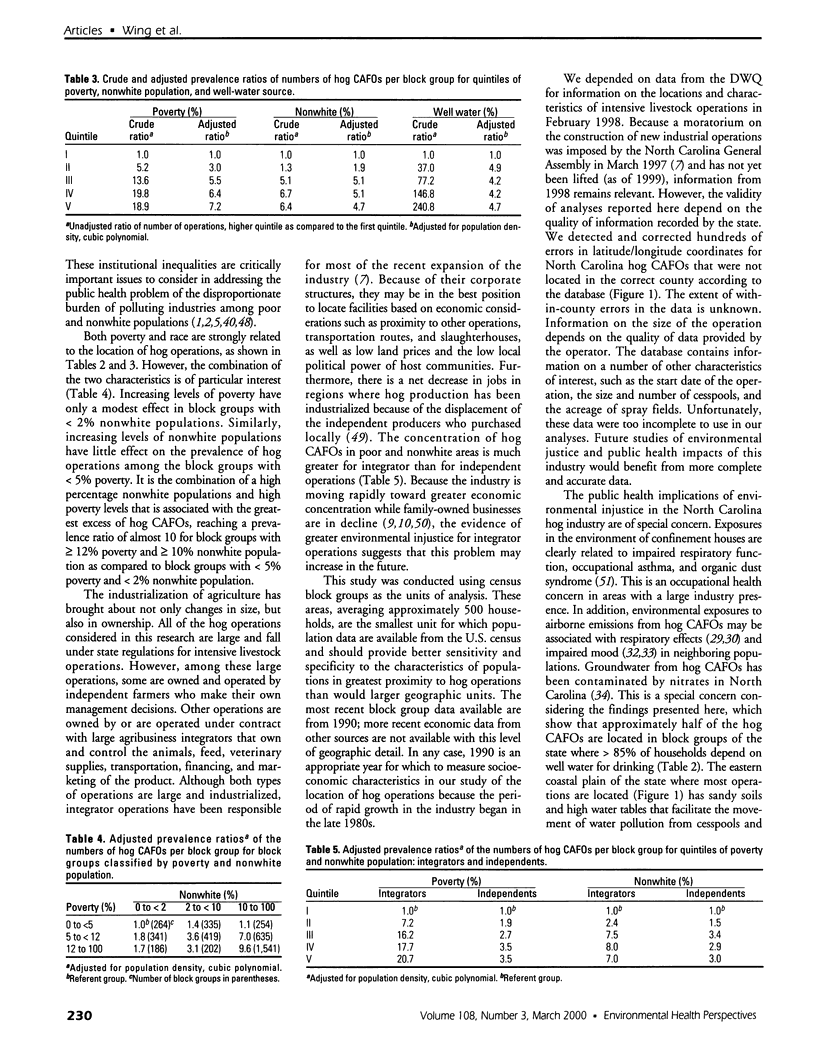
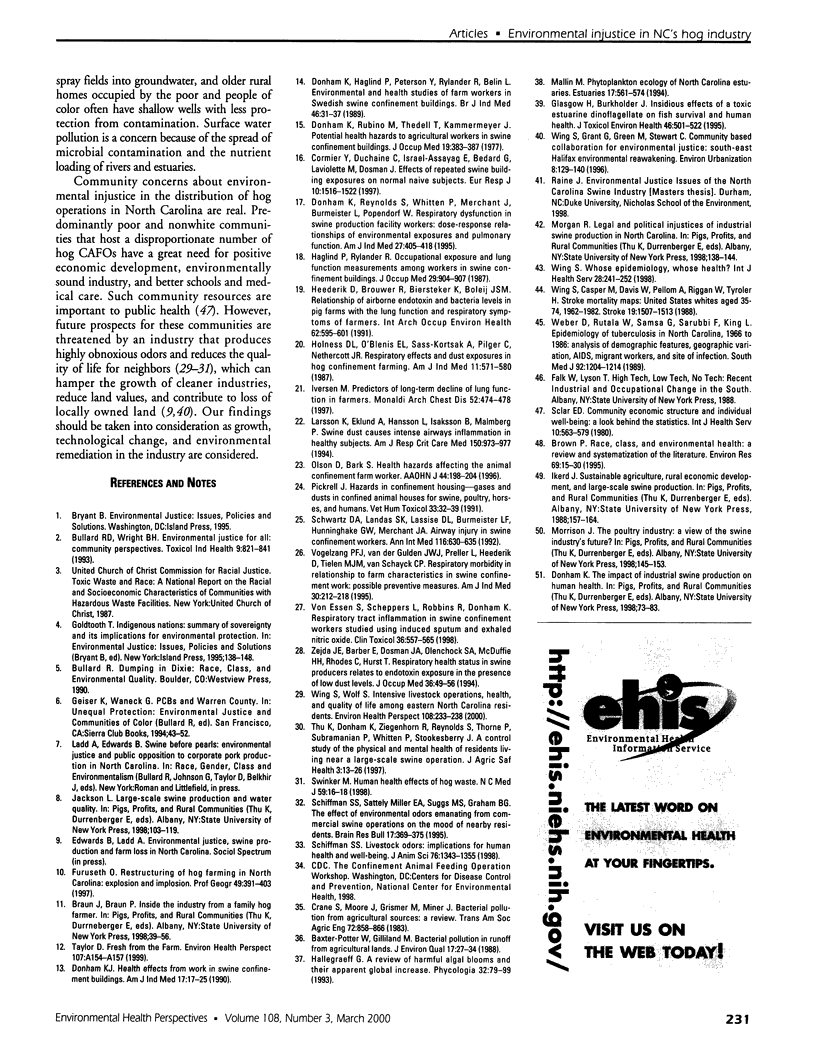
Images in this article
Selected References
These references are in PubMed. This may not be the complete list of references from this article.
- Bullard R. D., Wright B. H. Environmental justice for all: community perspectives on health and research needs. Toxicol Ind Health. 1993 Sep-Oct;9(5):821–841. doi: 10.1177/074823379300900508. [DOI] [PubMed] [Google Scholar]
- Cormier Y., Duchaine C., Israël-Assayag E., Bédard G., Laviolette M., Dosman J. Effects of repeated swine building exposures on normal naive subjects. Eur Respir J. 1997 Jul;10(7):1516–1522. doi: 10.1183/09031936.97.10071516. [DOI] [PubMed] [Google Scholar]
- Donham K. J., Reynolds S. J., Whitten P., Merchant J. A., Burmeister L., Popendorf W. J. Respiratory dysfunction in swine production facility workers: dose-response relationships of environmental exposures and pulmonary function. Am J Ind Med. 1995 Mar;27(3):405–418. doi: 10.1002/ajim.4700270309. [DOI] [PubMed] [Google Scholar]
- Donham K. J., Rubino M., Thedell T. D., Kammermeyer J. Potential health hazards to agricultural workers in swine confinement buildings. J Occup Med. 1977 Jun;19(6):383–387. doi: 10.1097/00043764-197706000-00004. [DOI] [PubMed] [Google Scholar]
- Donham K., Haglind P., Peterson Y., Rylander R., Belin L. Environmental and health studies of farm workers in Swedish swine confinement buildings. Br J Ind Med. 1989 Jan;46(1):31–37. doi: 10.1136/oem.46.1.31. [DOI] [PMC free article] [PubMed] [Google Scholar]
- Glasgow H. B., Jr, Burkholder J. M., Schmechel D. E., Tester P. A., Rublee P. A. Insidious effects of a toxic estuarine dinoflagellate on fish survival and human health. J Toxicol Environ Health. 1995 Dec;46(4):501–522. doi: 10.1080/15287399509532051. [DOI] [PubMed] [Google Scholar]
- Haglind P., Rylander R. Occupational exposure and lung function measurements among workers in swine confinement buildings. J Occup Med. 1987 Nov;29(11):904–907. [PubMed] [Google Scholar]
- Heederik D., Brouwer R., Biersteker K., Boleij J. S. Relationship of airborne endotoxin and bacteria levels in pig farms with the lung function and respiratory symptoms of farmers. Int Arch Occup Environ Health. 1991;62(8):595–601. doi: 10.1007/BF00381114. [DOI] [PubMed] [Google Scholar]
- Holness D. L., O'Blenis E. L., Sass-Kortsak A., Pilger C., Nethercott J. R. Respiratory effects and dust exposures in hog confinement farming. Am J Ind Med. 1987;11(5):571–580. doi: 10.1002/ajim.4700110509. [DOI] [PubMed] [Google Scholar]
- Iversen M. Predictors of long-term decline of lung function in farmers. Monaldi Arch Chest Dis. 1997 Oct;52(5):474–478. [PubMed] [Google Scholar]
- Larsson K. A., Eklund A. G., Hansson L. O., Isaksson B. M., Malmberg P. O. Swine dust causes intense airways inflammation in healthy subjects. Am J Respir Crit Care Med. 1994 Oct;150(4):973–977. doi: 10.1164/ajrccm.150.4.7921472. [DOI] [PubMed] [Google Scholar]
- Olson D. K., Bark S. M. Health hazards affecting the animal confinement farm worker. AAOHN J. 1996 Apr;44(4):198–206. [PubMed] [Google Scholar]
- Pickrell J. Hazards in confinement housing--gases and dusts in confined animal houses for swine, poultry, horses and humans. Vet Hum Toxicol. 1991 Feb;33(1):32–39. [PubMed] [Google Scholar]
- Schiffman S. S. Livestock odors: implications for human health and well-being. J Anim Sci. 1998 May;76(5):1343–1355. doi: 10.2527/1998.7651343x. [DOI] [PubMed] [Google Scholar]
- Schiffman S. S., Miller E. A., Suggs M. S., Graham B. G. The effect of environmental odors emanating from commercial swine operations on the mood of nearby residents. Brain Res Bull. 1995;37(4):369–375. doi: 10.1016/0361-9230(95)00015-1. [DOI] [PubMed] [Google Scholar]
- Schwartz D. A., Landas S. K., Lassise D. L., Burmeister L. F., Hunninghake G. W., Merchant J. A. Airway injury in swine confinement workers. Ann Intern Med. 1992 Apr 15;116(8):630–635. doi: 10.7326/0003-4819-116-8-630. [DOI] [PubMed] [Google Scholar]
- Sclar E. D. Community economic structure and individual well-being: a look behind the statistics. Int J Health Serv. 1980;10(4):563–579. doi: 10.2190/1K7N-N25A-BMJ7-PWAX. [DOI] [PubMed] [Google Scholar]
- Swinker M. Human health effects of hog waste. N C Med J. 1998 Jan-Feb;59(1):16–18. [PubMed] [Google Scholar]
- Taylor D. Fresh from the farm. Environ Health Perspect. 1999 Mar;107(3):A154–A157. doi: 10.1289/ehp.99107a154. [DOI] [PMC free article] [PubMed] [Google Scholar]
- Vogelzang P. F., van der Gulden J. W., Preller L., Heederik D., Tielen M. J., van Schayck C. P. Respiratory morbidity in relationship to farm characteristics in swine confinement work: possible preventive measures. Am J Ind Med. 1996 Aug;30(2):212–218. doi: 10.1002/(SICI)1097-0274(199608)30:2<212::AID-AJIM13>3.0.CO;2-#. [DOI] [PubMed] [Google Scholar]
- Von Essen S. G., Scheppers L. A., Robbins R. A., Donham K. J. Respiratory tract inflammation in swine confinement workers studied using induced sputum and exhaled nitric oxide. J Toxicol Clin Toxicol. 1998;36(6):557–565. doi: 10.3109/15563659809028049. [DOI] [PubMed] [Google Scholar]
- Wing S., Casper M., Davis W. B., Pellom A., Riggan W., Tyroler H. A. Stroke mortality maps. United States whites aged 35-74 years, 1962-1982. Stroke. 1988 Dec;19(12):1507–1513. doi: 10.1161/01.str.19.12.1507. [DOI] [PubMed] [Google Scholar]
- Wing S. Whose epidemiology, whose health? Int J Health Serv. 1998;28(2):241–252. doi: 10.2190/Y3GE-NQCK-0LNR-T126. [DOI] [PubMed] [Google Scholar]
- Wing S., Wolf S. Intensive livestock operations, health, and quality of life among eastern North Carolina residents. Environ Health Perspect. 2000 Mar;108(3):233–238. doi: 10.1289/ehp.00108233. [DOI] [PMC free article] [PubMed] [Google Scholar]
- Zejda J. E., Barber E., Dosman J. A., Olenchock S. A., McDuffie H. H., Rhodes C., Hurst T. Respiratory health status in swine producers relates to endotoxin exposure in the presence of low dust levels. J Occup Med. 1994 Jan;36(1):49–56. [PubMed] [Google Scholar]








